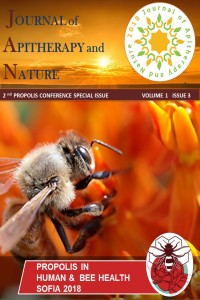Öz
The chemical composition of propolis is
highly variable and depends mainly on the local flora. Greece is characterized
by high biodiversity flora, assuming different propolis composition. Due to its
complex chemical constitution and its pharmaceutical and nutraceutical use worldwide, it
is necessary to characterize the quality of propolis and to guarantee a
reproducible quality, in order to ensure a safe use1. As a part of a
systematic research on different propolis, especially from Mediterranean area,
we report in this study the chemical analysis of three samples from Northeast
Aegean Greek islands (Samos,
Chios and Lesvos)
performed by GC/MS after silylation.
In
these samples diterpenes (abietic acid, imbricataloic acid, isoagatholal,
agathadiol, communic acid, pimaric acid, 13-epi-cupressic acid,
isocupressic acid totarol) have been identified as major constituents.
Especially Samos
and Chios
propolis samples showed high diterpene percentages (58 and 50%, respectively).
These findings confirm that both samples belong to the recently defined
“Mediterranean type”2, probably due to the presence of conifer trees
as main propolis plant sources.
All the ethanolic extracts of propolis samples have been evaluated for thei total phenolic content and
showed significant antibacterial activity against nine Gram-negative and
-positive human pathogenic bacteria and three fungi, probably due to the large
amounts of diterpenes. Furthermore they were evaluated for their inhibitory effects against 18 Malassezia strains (reference and clinical)3, concluding
that reach diterpene propolis may have interesting applications to control Malassezia
fungal-derived diseases.
Anahtar Kelimeler
Kaynakça
- 1. Bankova V., de Castro S.L., Marcucci M.C. (2000). Propolis: recent advances in chemistry and plant origin. Apidologie, 31: 3-15
- 2. Graikou K., Milena P., Gortzi O., Bankova V., Chinou I. (2016). Characterization and biological evaluation of selected Mediterranean propolis samples. Is it a new type? LWT-Food Science and Technology, 65: 261-267.
- 3. Velegraki A., Alexopoulos E.C., Kritikou S., Gaitanis G. (2004). Use of fatty acid RPMI 1640 media for testing susceptibilities of eight Malassezia species to the new triazole posaconazole and six established antifungal agents by a modified NCCLS M27-A2 microdilution method and E-test. Journal of Clinical Microbiology, 42: 3589-3593.
Öz
Kaynakça
- 1. Bankova V., de Castro S.L., Marcucci M.C. (2000). Propolis: recent advances in chemistry and plant origin. Apidologie, 31: 3-15
- 2. Graikou K., Milena P., Gortzi O., Bankova V., Chinou I. (2016). Characterization and biological evaluation of selected Mediterranean propolis samples. Is it a new type? LWT-Food Science and Technology, 65: 261-267.
- 3. Velegraki A., Alexopoulos E.C., Kritikou S., Gaitanis G. (2004). Use of fatty acid RPMI 1640 media for testing susceptibilities of eight Malassezia species to the new triazole posaconazole and six established antifungal agents by a modified NCCLS M27-A2 microdilution method and E-test. Journal of Clinical Microbiology, 42: 3589-3593.
Ayrıntılar
| Birincil Dil | İngilizce |
|---|---|
| Bölüm | 2nd Propolis Conference Special Issue |
| Yazarlar | |
| Yayımlanma Tarihi | 8 Aralık 2018 |
| Yayımlandığı Sayı | Yıl 2018 Cilt: 1 Sayı: 3 - 2nd Propolis Conference Special Issue |
Kaynak Göster
ASOS Index

